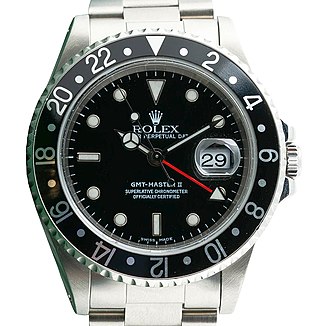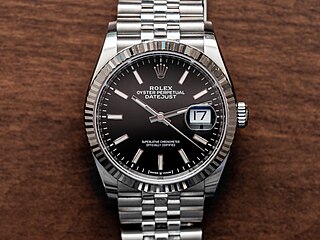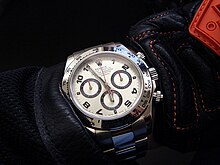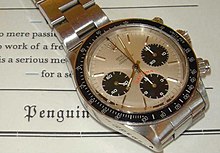
Rolex is a Swiss watch designer and manufacturer based in Geneva Switzerland. Founded in 1905 as Wilsdorf and Davis by Hans Wilsdorf and Alfred Davis in London, the company registered Rolex as the brand name of its watches in 1908 and became Rolex Watch Co. Ltd in 1915. After World War I, the company moved its base of operations to Geneva because of the unfavorable economy in the United Kingdom. In 1920, Hans Wilsdorf registered Montres Rolex SA in Geneva as the new company name ; it later became Rolex SA. Since 1960, the company has been owned by the Hans Wilsdorf Foundation, a private family trust.

Omega SA is a Swiss luxury watchmaker based in Biel/Bienne, Switzerland. Founded by Louis Brandt in La Chaux-de-Fonds in 1903, the company formerly operated as La Generale Watch Co. until incorporating the name Omega in 1903, becoming Louis Brandt et Frère-Omega Watch & Co. In 1984, the company officially changed its name to Omega SA and opened its museum in Biel/Bienne to the public. Omega is a subsidiary of The Swatch Group.

Patek Philippe SA is a Swiss luxury watch and clock manufacturer, located in the Canton of Geneva and the Vallée de Joux. Established in 1839, it is named after two of its founders, Antoni Patek and Adrien Philippe. Since 1932, the company has been owned by the Stern family in Switzerland and remains the last family-owned independent watch manufacturer in Geneva. Patek Philippe is one of the oldest watch manufacturers in the world with an uninterrupted watchmaking history since its founding. It designs and manufactures timepieces as well as movements, including some of the most complicated mechanical watches. The company maintains over 400 retail locations globally and over a dozen distribution centers across Asia, Europe, North America, and Oceania. In 2001, it opened the Patek Philippe Museum in Geneva.

A chronograph is a specific type of watch that is used as a stopwatch combined with a display watch. A basic chronograph has an independent sweep second hand and a minute sub-dial; it can be started, stopped, and returned to zero by successive pressure on the stem. More complex chronographs use additional complications and can have multiple sub-dials to measure seconds, minutes, hours and even fractions of a second. In addition, many modern chronographs use moveable bezels as tachymeters for rapid calculations of speed or distance. Louis Moinet invented the chronograph in 1816 for use in tracking astronomical objects. Chronographs were also used heavily in artillery fire in the mid to late 1800s. More modern uses of chronographs involve aircraft piloting, auto racing, diving and submarine maneuvering.

Zenith SA is a Swiss luxury watchmaker. The company was started in 1865 by Georges Favre-Jacot in Le Locle in the canton of Neuchâtel and is one of the oldest continuously operating watchmakers. Favre-Jacot invented the concept of "in house movements", believing that only through control of the entire watchmaking process could the highest quality be achieved. Zenith was purchased by LVMH in November 1999, becoming one of several brands in its watch and jewelry division, which includes TAG Heuer and Hublot. Benoit de Clerck is president and CEO.

In horology, a complication is any feature of a timepiece beyond the display of hours, minutes and seconds. A timepiece indicating only hours, minutes and seconds is known as a simple movement. Common complications include date or day-of-the-week indicators, alarms, chronographs (stopwatches), and automatic winding mechanisms. Complications may be found in any clock, but they are most notable in mechanical watches where the small size makes them difficult to design and assemble. A typical date-display chronograph may have up to 250 parts, while a particularly complex watch may have a thousand or more parts. Watches with several complications are referred to as grandes complications.

Audemars Piguet Holding SA is a Swiss manufacturer of ultra luxury watches, headquartered in Le Brassus, Switzerland. The company was founded by Jules Louis Audemars and Edward Auguste Piguet in the Vallée de Joux in 1875, acquiring the name Audemars Piguet & Cie in 1881. The company has been family-owned since its founding.

Omega Speedmaster is a line of chronograph wristwatches produced by Omega SA. While chronographs have been around since the late 1800s, Omega first introduced this line of chronographs in 1957. Since then, many different chronograph movements have been marketed under the Speedmaster name. Astronaut Walter Schirra was the first person to wear one in space in 1962 during his Mercury-Atlas 8 mission. The manual winding Speedmaster Professional or "Moonwatch" is the best-known and longest-produced; it was worn during the first American spacewalk as part of NASA's Gemini 4 mission, and was the first watch worn by an astronaut walking on the Moon during the Apollo 11 mission. The Speedmaster Professional remains one of several watches qualified by NASA for spaceflight, and is still the only one so qualified for EVA. The Speedmaster line also includes other models, including analog-digital and automatic mechanical watches.

The Rolex Oyster Perpetual Date GMT Master is part of the Rolex Professional Watch Collection. Designed in collaboration with the now defunct Pan American Airways of the United States for use by their pilots and navigators, it was launched in 1954.

The Rolex Oyster Perpetual Submariner is a line of sports watches designed for diving and manufactured by Rolex, resistant to water and corrosion. The first Submariner was introduced to the public in 1954 at the Basel Watch Fair. It was the first watch to be waterproof up to 100 metres (330 ft). The Rolex Submariner is considered "a classic among wristwatches", manufactured by one of the most widely recognized luxury brands in the world. Due to its huge popularity, there are many homage watches by well-established watchmakers, as well as illegal counterfeits. The Rolex Submariner is part of Rolex's Professional line.

The Rolex Oyster Perpetual Datejust is a self-winding chronometer manufactured by Rolex. Launched in 1945, the Datejust was the first self-winding chronometer wristwatch to indicate the date in a window on the dial. Today, it is available in a variety of sizes from 28mm to 41mm, in stainless steel, two-tone gold, and solid gold versions.

F. P. Journe, legally Montres Journe SA, is a Swiss-French high-end watch Manufacture d'horlogerie founded in 1999 by François-Paul Journe. The only three-time winner of the Aiguille d'Or grand prize from the Fondation du Grand Prix d'Horlogerie de Genève, Journe focuses on complex precision chronometers with a production of around 800 watches per year. 20% of the company was acquired by Chanel in 2018 for an undisclosed amount.
The J12 is a line of Swiss made luxury watches introduced in 1999 by French haute couture house Chanel. The J12 was launched in 1999 and is considered as a unisex watch. The watch was designed by the artistic director of the house, Jacques Hélleu, who found inspiration in the two worlds he loved most: automobiles and sailing. Chanel uses highly scratch-resistant ceramic for the watch's case and bracelet. Other materials are used as well, such as titanium and for one of the house's limited edition watches, sapphires were used to create the entirety of the bracelet and case.
Universal Genève SA is a Swiss luxury watch company, founded in 1894 as Universal Watch. It is a subsidiary of Breitling SA. Since its beginnings, the company has produced complete watches with in-house movements. Along with neighboring Geneva companies Audemars Piguet, Girard-Perregaux, Patek Philippe and Rolex, Universal is internationally regarded for its style of craftsmanship as a manufacture d'horlogerie. Universal Genève is known for creating the first-ever chronograph in 1917.

The TAG Heuer Monaco, initially introduced by Heuer in 1969, is a line of automatic chronograph wristwatches created to commemorate the Monaco Grand Prix. Notable for its distinctive square case, the Monaco was among the first of its kind in this design, following Rolex's introduction of a square chronograph in 1940. The watch gained significant recognition after Steve McQueen wore it in the 1971 film Le Mans, which, over time, has closely associated it with the actor. Despite being phased out in the mid-1970s, the Monaco was reintroduced in 1998 with a redesigned appearance and again in 2003 with new mechanisms, reflecting a renewed interest in McQueen's legacy.

The Rolex Oyster Perpetual Day-Date is a COSC certified, self-winding chronometer manufactured by Rolex. Initially presented in 1956, the Day-Date was the first watch to display the date as well as the day, spelled in full. The calendar display is offered in 26 languages.

The Omega Bullhead was introduced in 1969 as part of the Chronostop range, it was marketed as drivers / rally watch and was nicknamed the "Bullhead" because of the configuration of the winding crown being located at 12 o'clock with the chronograph pushers on either side.

Montres Tudor SA, or simply Tudor, is a Swiss watchmaker based in Geneva, Switzerland. Registered in 1926 by Hans Wilsdorf, founder of Rolex, the brand remains a sister company to Rolex; both companies are owned by the Hans Wilsdorf Foundation. Tudor was initially known for watches produced for the military and professional divers. From the 1960s to 1980s, several navies issued Tudor Submariners to their divers, including the US Navy SEALs and the French Marine Nationale.
Philippe Dufour, AHCI is a Swiss-born watchmaker from Le Sentier, Vallée de Joux. He is regarded as a master of modern watchmaking, and his watches are referenced as among the best ever made. He finishes all of his watches himself by hand. In 1992, Dufour was the first watchmaker to put arguably the most complex of complications in a wristwatch, a Sonnerie. His other two models include Duality and Simplicity.




















